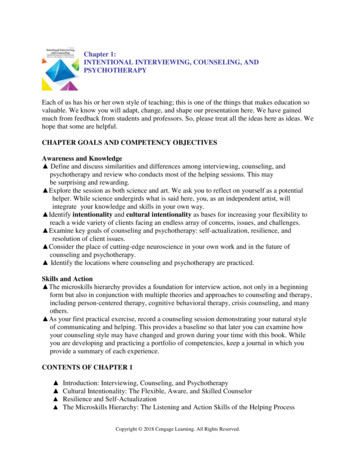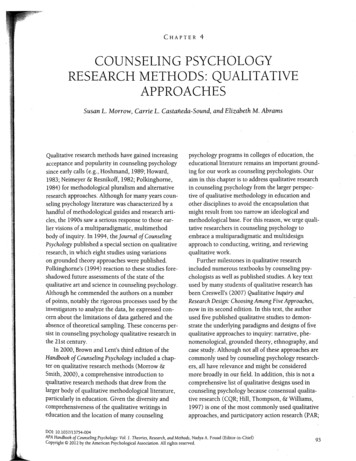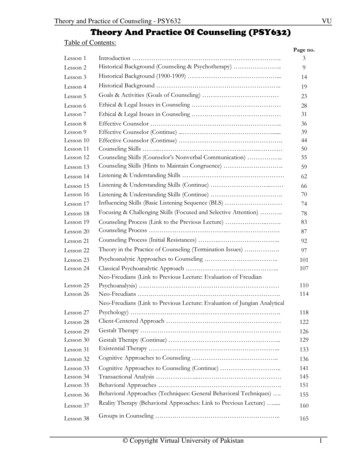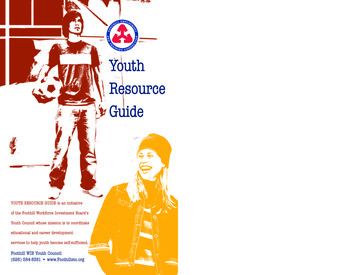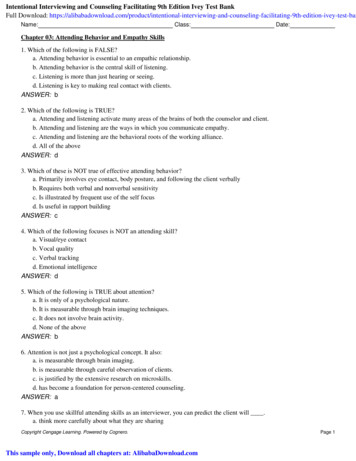
Transcription
Intentional Interviewing and Counseling Facilitating 9th Edition Ivey Test BankFull Download: -ivey-test-banName:Class:Date:Chapter 03: Attending Behavior and Empathy Skills1. Which of the following is FALSE?a. Attending behavior is essential to an empathic relationship.b. Attending behavior is the central skill of listening.c. Listening is more than just hearing or seeing.d. Listening is key to making real contact with clients.ANSWER: b2. Which of the following is TRUE?a. Attending and listening activate many areas of the brains of both the counselor and client.b. Attending and listening are the ways in which you communicate empathy.c. Attending and listening are the behavioral roots of the working alliance.d. All of the aboveANSWER: d3. Which of these is NOT true of effective attending behavior?a. Primarily involves eye contact, body posture, and following the client verballyb. Requires both verbal and nonverbal sensitivityc. Is illustrated by frequent use of the self focusd. Is useful in rapport buildingANSWER: c4. Which of the following focuses is NOT an attending skill?a. Visual/eye contactb. Vocal qualityc. Verbal trackingd. Emotional intelligenceANSWER: d5. Which of the following is TRUE about attention?a. It is only of a psychological nature.b. It is measurable through brain imaging techniques.c. It does not involve brain activity.d. None of the aboveANSWER: b6. Attention is not just a psychological concept. It also:a. is measurable through brain imaging.b. is measurable through careful observation of clients.c. is justified by the extensive research on microskills.d. has become a foundation for person-centered counseling.ANSWER: a7. When you use skillful attending skills as an interviewer, you can predict the client will .a. think more carefully about what they are sharingCopyright Cengage Learning. Powered by Cognero.This sample only, Download all chapters at: AlibabaDownload.comPage 1
Name:Class:Date:Chapter 03: Attending Behavior and Empathy Skillsb. pay more attention to interviewer instructionsc. share a more complete story with fewer topic jumpsd. express more emotional releaseANSWER: c8. Attending behavior on the part of the helping professional .a. is making sure the client is comfortable before the session beginsb. is attending to client needs as they arise in the sessionc. is encouraging client talk and reducing interviewer talkd. is noting accurate details in the report following the sessionANSWER: c9. Cultural differences:a. reveal clearly that counseling across cultures is virtually impossible.b. reveal little in the way of personal or group differences.c. must be taken into account, but only with groups with whom one has experience.d. are an important factor that must be considered in every counseling session.ANSWER: d10. Attending skills:a. exist in all cultures, but may be expressed differently.b. remain the same from culture to culture.c. are very similar, but differ occasionally in cultures.d. enable an interviewer to communicate with people of other cultures at a very rapid rate.ANSWER: a11. Which of the following is NOT a component of attending behavior?a. Attentive and authentic body languageb. Verbal mirroring techniquec. Visual/eye contactd. Verbal trackingANSWER: b12. Who introduced the attending behavior concepts to the helping field?a. Ivey et al.b. Freud et al.c. Skinner et al.d. Rogers et al.ANSWER: a13. Which of the following statements is NOT accurate?a. Attending behavior is primarily concerned with noting body language.b. The multicultural background of each client may modify his or her communicating style.c. Good observers encourage clients to talk more.Copyright Cengage Learning. Powered by Cognero.Page 2
Name:Class:Date:Chapter 03: Attending Behavior and Empathy Skillsd. The counselor may need to adapt his or her style to meet the needs of the client.ANSWER: a14. Which of the following is TRUE?a. Many beginning counselors to try to solve clients' difficulties too soon.b. Most clients develop their concerns over a brief period of time.c. It is critical for counselors to speed up in focusing on clients' problems and solutions.d. Using the three Vs and one B is a waste of time during an intake session.ANSWER: a15. According to the authors, the most effective eye contact for attending .a. depends on the cultural and socioeconomic factors of the intervieweeb. requires consistent visual contact with the intervieweec. demands avoiding eye contact with the intervieweed. respects multicultural preferencesANSWER: d16. Regarding visual/eye contact, which of the following is NOT true?a. Direct eye contact is considered a sign of interest by European–North American middle classes.b. Direct eye contact is considered a sign of disrespect by Native American and Latin American young people.c. Direct eye contact is generally avoided by Inuit and Aboriginal Australians.d. Direct eye contact differences are easily noted, but cultural differences are so varied that findings areinconclusive and unhelpful.ANSWER: d17. Direct but not constant eye contact is typical for:a. African American clients.b. Hispanic clients.c. White middle-class clients.d. all of the above.ANSWER: c18. Which of the following may be observed when an interview issue is of interest to a middle-class client?a. Direct eye contact, forward trunk lean, pupil dilationb. Direct eye contact, forward trunk lean, pupil contractionc. Partial eye contact, forward trunk lean, pupil dilationd. Partial eye contact, trunk lean away, pupil contractionANSWER: a19. Members of which cultural groups are most likely to reject direct eye contact, particularly if they are coming from atraditional background?a. White middle-class and Latina/Latino clientsb. Native American and Latina/Latino clientsc. African American women and White childrenCopyright Cengage Learning. Powered by Cognero.Page 3
Name:Class:Date:Chapter 03: Attending Behavior and Empathy Skillsd. None of the aboveANSWER: b20. Vocal qualities mean:a. tracking the client's story without interruption.b. noting what clients discuss and what they avoid.c. moderating your tone and speech rate to the client and the situation.d. facing the client when you are speaking with them.ANSWER: c21. Which of the following is NOT a vocal qualities behavior?a. Speech hesitationsb. Verbal changes of topicc. Throat clearingd. Screaming and whisperingANSWER: b22. Clients and interviewers may use to highlight the important issues in their statements.a. verbal underlining, topic jumps, and softer vocal toneb. verbal underlining, keeping to the same topic, and higher pitchc. verbal underlining to key words or phrasesd. written instructionsANSWER: c23. Clients and interviewers highlight important issues in their statements through:a. written instructions.b. verbal underlining, keeping to the same topic, and higher pitch.c. verbal underlining, topic jumps, and softer vocal tone.d. verbal underlining, volume, and emphasis on key words or phrases.ANSWER: d24. Both interviewers and clients may find themselves speaking with louder volume and increased vocal emphasis forcertain words and short phrases. This is known as:a. verbal tracking.b. vocal tone.c. verbal underlining.d. vocal quality.ANSWER: c25. is/are a particularly good example of how different people react differently to the same voice.a. Clients changing the topicb. Interviewer’s national or regional accentc. Client vocal tonesd. Interviewer’s skillful attending skillsCopyright Cengage Learning. Powered by Cognero.Page 4
Name:Class:Date:Chapter 03: Attending Behavior and Empathy SkillsANSWER: b26. Vocal qualities and verbal tracking:a. are essentially the same skill.b. are secondary and tertiary attending skills.c. are NOT interviewer skills.d. are distinctly different and critical attending skills.ANSWER: d27. Which one of the following statements may help a new interviewer become aware of their own pattern of selectiveattention?a. Relax. Build on the client’s topic and learn about your client over time.b. You don’t want to lose track of key issues, but you can’t attack every client issue at once.c. Be alert to your own pattern of selective attention.d. All of the above.ANSWER: d28. We tend to listen to some topics more than others by verbal tracking. We hear some topics better than others. It isimportant that the interviewer be aware of unconscious patterns of:a. selective attention.b. pupil dilation.c. verbal underlining.d. client topic jumps.ANSWER: a29. Which of the following is NOT true of selective attention?a. Selective attention is simply interviewers noting the topics to which clients attend.b. Clients tend to talk about what interviewers are willing to hear.c. It is just as important for interviewers to observe how they selectively attend to specific topics.d. Interviewers may have a limited list of topics that interest them.ANSWER: a30. It is important for the counselor to be aware of his/her own patterns of:a. verbal underlining.b. selective attention.c. pupil dilation.d. client topic jumps.ANSWER: b31. Staying with the topic is important in:a. verbal underlining.b. verbal tracking.c. most non-attending responses.d. effective vocal qualities.Copyright Cengage Learning. Powered by Cognero.Page 5
Name:Class:Date:Chapter 03: Attending Behavior and Empathy SkillsANSWER: b32. Selective attention, a key concept introduced in the microskills framework,:a. is less important in key theories of helping such as person-centered and brief counseling.b. is based on the brain being wired to attend stimuli to cope with the environment.c. is brought about by the hippocampus and the energizing amygdala through selective memory.d. has become the central concept of person-centered and brief counseling.ANSWER: b33. Which of the following is FALSE concerning verbals?a. Selective attention occurs when we listen only to one person at a time.b. Most of us have certain topics that we are more interested in than others.c. It is important to stay with the topic introduced by the client.d. It can be helpful if we learn our own patterns of selective attention.ANSWER: a34. Redirecting attention is:a. avoided by effective interviewers.b. not a valid skill for the interviewer.c. useful in shifting clients away from negative topics.d. rude behavior on the part of the interviewer.ANSWER: c35. Through , we can sometimes stop clients from talking about nonproductive topics.a. selective attentionb. verbal underliningc. redirecting attentiond. threats and criticismANSWER: c36. Which of the following is TRUE about redirecting attention?a. It is always inappropriate.b. It can help a client stop repeating a story over and over.c. It facilitates clients talking even more about their issues.d. It encourages clients to talk about positive things.ANSWER: b37. Silence:a. needs to be avoided in some cultural contexts.b. is central when you are working with a client whom you do not really understand as it gives them more time tothink and talk.c. can be frightening to the beginning helper.d. is difficult for clients, so the counselor needs to fill in the time.ANSWER: cCopyright Cengage Learning. Powered by Cognero.Page 6
Name:Class:Date:Chapter 03: Attending Behavior and Empathy Skills38. Which of the following is TRUE about silence?a. It can cause client discomfort and must be used sparingly.b. It can be useful in a session when clients need to think through their responses.c. It is not a useful tool for the helping professional.d. It is useful when followed by detailed analysis of the client's issue(s).ANSWER: b39. Which of the following determines comfortable interpersonal distance between people?a. Ethnic or regional heritageb. Agec. Specific topics of conversationd. All of the aboveANSWER: d40. Which of the following is TRUE about body language?a. A comfortable conversational distance for traditional Arab Americans is more than an arm’s length.b. English-speaking people generally prefer a conversation at slightly less than half an arm’s length.c. Leaning forward closely toward a Latina/Latino friend will often be received as intrusive.d. A comfortable conversational distance for North Americans is slightly more than arm’s length.ANSWER: d41. When it comes to appropriate interviewer body language, is essential to building trust.a. sitting straight in your chairb. skillfully executed techniquec. relaxed open armsd. authenticityANSWER: d42. According to the authors, which of the following is TRUE about empathy?a. Empathy can exist without counseling skills.b. Empathy is a way to introduce caring into the session.c. The use of microskills produces empathy.d. Microskills can be more meaningful if combined with empathic constructs.ANSWER: d43. Empathy is defined as experiencing:a. the client's worldview.b. the world as if you are the client.c. awareness that you are separate from the client.d. the world as if you were the client, but being aware that you are separate from the client.ANSWER: d44. Empathy is often defined as:Copyright Cengage Learning. Powered by Cognero.Page 7
Name:Class:Date:Chapter 03: Attending Behavior and Empathy Skillsa. comforting the client through difficult emotions.b. experiencing the world as if you were the client.c. the same as sympathy.d. being kind to the client when he or she is troubled.ANSWER: b45. Empathy:a. requires the interviewer to respond immediately to each expression of emotion from the client.b. requires the interviewer to accurately say key issues back to client without adding his or her own thoughts.c. requires the interviewer to mirror each emotion the client expresses.d. is failure of the client to express emotion during the session.ANSWER: b46. Empathy is best assessed by:a. your level of identification with your client.b. the client’s reaction to your statement.c. the grammatical quality of your statement.d. the accuracy of your interpretation.ANSWER: b47. Who was the first person to measure levels of empathic understanding?a. Rogersb. Truaxc. Maslowd. IveyANSWER: b48. You can observe interview sessions and rate the use of interviewer empathy using which of the following scales?a. Level 1: Additive empathy; Level 2: Basic empathy; Level 3: Subtractive empathyb. Level 1: Subtractive empathy; Level 2: Basic empathy; Level 3: Additive empathyc. Level 1: Basic empathy; Level 2: Additive empathy; Level 3: Subtractive empathyd. Level 1: Additive empathy; Level 2: Subtractive empathy; Level 3: Basic empathyANSWER: b49. Which of the following lists, in the correct order, the three anchor points used to classify and rate the quality ofempathy shown in an interview?a. Level 1: Additive empathy; Level 2: Basic empathy; Level 3: Subtractive empathyb. Level 1: Basic empathy; Level 2: Additive empathy; Level 3: Subtractive empathyc. Level 1: Subtractive empathy; Level 2: Basic empathy; Level 3: Additive empathyd. Level 1: Additive empathy; Level 2: Subtractive empathy; Level 3: Basic empathyANSWER: c50. When the interviewer focuses on the negative or distorts the client's conversation, this is:a. empathy.Copyright Cengage Learning. Powered by Cognero.Page 8
Name:Class:Date:Chapter 03: Attending Behavior and Empathy Skillsb. subtractive empathy.c. basic empathy.d. additive empathy.ANSWER: b51. The counselor responds to Dominic with, “I heard you saying that things are great, but how do you really feel aboutdoing ‘women's work'?” How would you rate this confrontation on empathy?a. Level 1, subtractiveb. Level 2, somewhat subtractivec. Level 3, interchangeabled. Level 4, somewhat additiveANSWER: a52. When the interviewer links to an earlier client comment, introduces a new frame of reference, or initiates the positiveasset search, these are components of:a. empathy.b. subtractive empathy.c. basic empathy.d. additive empathy.ANSWER: d53. When the interviewer paraphrases and reflects feeling to communicate that he or she understands the client, this is:a. empathy.b. subtractive empathy.c. basic empathy.d. additive empathy.ANSWER: a54. When the interviewer's responses are basically interchangeable with those of the client, this is:a. empathy.b. subtractive empathy.c. basic empathy.d. additive empathy.ANSWER: c55. Basic empathy is best defined as:a. the interviewer interchanges responses with the client.b. the interviewer changes roles with the client.c. the relationship is one of equity and understanding.d. the interviewer accurately says back to the client what has been said.ANSWER: d56. The interviewer is demonstrating when he/she is able to say back accurately what theclient has said.Copyright Cengage Learning. Powered by Cognero.Page 9
Name:Class:Date:Chapter 03: Attending Behavior and Empathy Skillsa. basic empathyb. additive empathyc. subtractive empathyd. none of the aboveANSWER: a57. When demonstrating the interviewer is able to offer a congruent idea or frame of referencethat helps the client see a new perspective.a. basic empathyb. additive empathyc. subtractive empathyd. none of the aboveANSWER: b58. Inappropriate interviewer responses that give back less or distort what the client has said demonstrate .a. basic empathyb. additive empathyc. subtractive empathyd. none of the aboveANSWER: c59. An empathic person who watches a partner being shocked in an experiment:a. draws on memories from the hippocampus to deal with the strain.b. draws on the amygdala to understand the other.c. actually feels his or her partner’s pain, even though just watching.d. has some parallel pain centers activated in his or her brain.ANSWER: d60. Mirror neurons:a. fire up when clients look at themselves.b. guide clients’ grooming behavior.c. fire up when clients observe actions by others.d. fire up when clients look into a mirror.ANSWER: c61. Empathy is not just a psychological concept. It also:a. is measurable through brain imaging.b. is measurable through careful observation of your actions.c. is assessed by the extensive research on microskills.d. has become a foundation for person-centered counseling.ANSWER: a62. Which of the following disruptive behaviors can lead to a poor session?a. Visual contactCopyright Cengage Learning. Powered by Cognero.Page 10
Name:Class:Date:Chapter 03: Attending Behavior and Empathy Skillsb. Verbal trackingc. Body languaged. All of the aboveANSWER: d63. In every interview the quality of attending and nonattending responses .a. is always the sameb. depends on how actively you demonstrate attendingc. depends on the situationd. depends on how well versed you are in expressing nonattentionANSWER: c64. In all of the examples, we can assume:a. the attending responses were the best.b. the nonattending responses were the best.c. quality would depend on the situation.d. a and c.ANSWER: c65. Teaching attending behavior to clients is recommended by the authors because:a. it will make clients into beginning interviewers and counselors.b. it provides something to do when the interview begins to slow down.c. research and counseling practice has revealed that it can be highly beneficial to many clients.d. all of the aboveANSWER: c66. The microskills can best be taught to:a. many client and volunteer populations.b. hospitalized inpatients during the early stages of treatment.c. high school peer counselors.d. volunteers in the community.ANSWER: a67. Social skills training may refer to .a. dating behaviorb. drug-refusal skillsc. assertiveness trainingd. all of the aboveANSWER: d68. Which of the following is FALSE about teaching the microskills to challenging clients in different settings?a. Depressed hospitalized patients do not respond well to social skills treatment.b. Teaching troubled clients the attending skills is usually effective.c. Attending skills improve the preparation of high school peer mediators.Copyright Cengage Learning. Powered by Cognero.Page 11
Name:Class:Date:Chapter 03: Attending Behavior and Empathy Skillsd. Communication with troubled children can be regained by using the attending skills.ANSWER: a69. Being aware of what one is doing can interfere with coordination and smoothness. This is known in microskillstraining as .a. the difficulty of practiceb. the Samurai Effectc. the need for fewer skills and a simplified model of training for some beginnersd. the nonverbal effectANSWER: b70. Practice in meditation:a. has recently become important in person-centered counseling as a key strategy.b. can help samurai forget the individual skills in order to master them.c. facilitates emotional growth through taming the amygdala.d. is a strategy that should only be used with a very few clients.ANSWER: b71. Learning attending and the other microskills involves breaking each skill to its smallest component and is similar to.a. how samurai learn swordplayb. learning to drive a car for the first timec. becoming proficient with demanding activities: sports, dance, musicd. all of the aboveANSWER: d72. As the interviewer, when you don't know what to do next, which of the following should you do?a. Continue attending to the client.b. Ask the client to start over.c. Consult your notes regarding the client's issues.d. End the session.ANSWER: a73. Which of the following represents one of Shenk’s findings regarding excellence?a. Practice changes your mind but not your body.b. Skills are nonspecific.c. The brain drives the brawn.d. All of the aboveANSWER: c74. Which of the following is NOT one of the suggested guidelines for effective feedback?a. Feedback is most helpful when it includes strengths.b. Feedback is most helpful when it is comprehensive and generalized.c. Feedback is most helpful when it is relatively nonjudgmentalCopyright Cengage Learning. Powered by Cognero.Page 12
Name:Class:Date:Chapter 03: Attending Behavior and Empathy Skillsd. Feedback is most helpful when it is lean and concrete.ANSWER: b75. According to the authors, attending behavior and listening are essential for human communication but need to betailored according to individual and multicultural differences.a. Trueb. FalseANSWER: True76. Without attention, nothing will happen.a. Trueb. FalseANSWER: True77. Smiling, listening, and a respectful and understanding vocal tone are behaviors that “fit” virtually all cultures andindividuals.a. Trueb. FalseANSWER: True78. Empathy is identifiable by means of functional magnetic resonance imaging (fMRI).a. Trueb. FalseANSWER: True79. Present a concrete example of a time when it may be appropriate NOT to provide attention (attending behavior toclient talk).ANSWER: Answers may vary80. What are the four main concepts of attending behavior? Evaluate yourself on each of these.ANSWER: Answers may vary81. Describe cultural differences that may exist in the four main concepts of attending behavior.ANSWER: Answers may vary82. Define and provide an example of the following terms:verbal underliningselective attentionANSWER: Answers may vary83. Provide examples of effective attending and effective nonattending counselor responses to this client:Client: "It was a long, hard hearing. The lawyer kept questioning me about the so-called 'assault' for two hours. I'm notguilty, and I didn't do it. I can't see why they are after me all the time."Copyright Cengage Learning. Powered by Cognero.Page 13
Name:Class:Date:Chapter 03: Attending Behavior and Empathy SkillsANSWER: Answers may vary84. Explain the acronym “3 Vs B” and provide examples of each aspect.ANSWER: Answers may vary85. Explain what “topic jumps” means. Describe what interviewers can do to prevent or cope with it. Provide examples.ANSWER: Answers may vary86. Describe the concept and discuss the pros and cons of using silence in the interview.ANSWER: Answers may vary87. How might you go about teaching the skill of attending? Illustrate your discussion with an example of a client problemsuch as shyness, lack of friendship, depression, or another specific issue.ANSWER: Answers may vary88. Describe the Samurai Effect and its relevance for the mastery of the microskills.ANSWER: Answers may vary89. Discuss the concepts of basic empathy, subtractive empathy, and additive empathy, and give an example of each.ANSWER: Answers may vary90. Explain what mirror neurons are and how they support empathy.ANSWER: Answers may vary91. What are the guidelines for effective feedback, and how have you found them useful in your own session practice?ANSWER: Answers may vary92. Clients and interviewers highlight important issues in their statements through:a. written instructions.b. verbal underlining, keeping to the same topic, and higher pitch.c. verbal underlining, topic jumps, and softer vocal tone.d. verbal underlining, volume and emphasis on key words or phrases.ANSWER: d93. Which of the following is TRUE of visuals?a. We always need to strive for eye contact.b. In some cultures, eye contact is always considered inappropriate.c. Men have better eye contact than women.d. Culturally and individually appropriate eye contact is essential.ANSWER: d94. When demonstrating the interviewer is able to offer a congruent idea or frame of referencethat helps the client see a new perspective.a. basic empathyb. additive empathyCopyright Cengage Learning. Powered by Cognero.Page 14
Name:Class:Date:Chapter 03: Attending Behavior and Empathy Skillsc. subtractive empathyd. none of the aboveANSWER: b95. Inappropriate interviewer responses that give back less or distort what the client has said demonstrate .a. basic empathyb. additive empathyc. subtractive empathyd. none of these choicesANSWER: c96. Teaching attending behavior to clients is recommended by the authors because:a. it will make clients into beginning interviewers and counselors.b. it provides something to do when the interview begins to slow down.c. research and counseling practice has revealed that it can be highly beneficial to many clients.d. all of these.ANSWER: c97. Even the most advanced professional doesn’t always know what is happening. What can you do when youdon’t know what to do?a. Questionb. Attendc. Interruptd. ChallengeANSWER: b98. Empathy can be rated as:a. interchangeable.b. subtractive.c. additive.d. all of the theseANSWER: d99. The authors point out that is essential if you are to truly master and become competent in the interview.a. Practiceb. Practice, practicec. Practice, practice, and practiced. None of theseANSWER: c100. Which cultural groups are most likely to reject direct eye contact, particularly if coming from a traditionalbackground?a. White middle-class and Latina/Latino clientsb. Native American and Latina/Latino clientsCopyright Cengage Learning. Powered by Cognero.Page 15
Intentional Interviewing and Counseling Facilitating 9th Edition Ivey Test BankFull Download: -ivey-test-banName:Class:Date:Chapter 03: Attending Behavior and Empathy Skillsc. African-American women and White childrend. None of theseANSWER: b101. It is important to use respectful language in dealing with those who may have a physical disability. Which of thefollowing terms is NOT considered appropriate?a. AIDS victimb. A person with AIDSc. A person with hearing lossd. Deaf cultureANSWER: aCopyright Cengage Learning. Powered by Cognero.This sample only, Download all chapters at: AlibabaDownload.comPage 16
a. is less important in key theories of helping such as person-centered and brief counseling. b. is based on thebrain being wired toattend stimuli cope with environment. c. is brought about by thehippocampus and energizing amygdala through selective memory. d. has become the central concept of person-centered and brief counseling. ANSWER: b 33.
